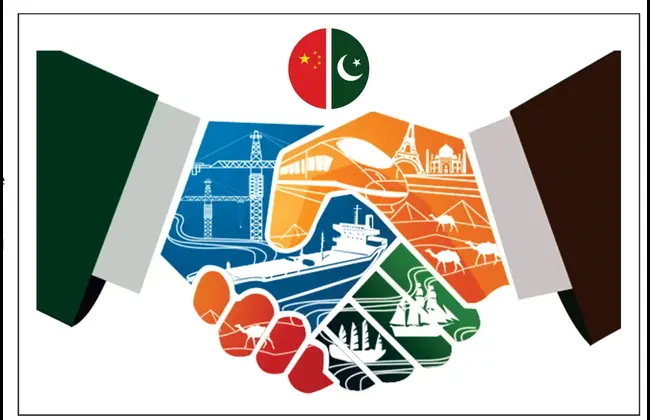The benefits of CPEC
For the first time, Lahore witnessed a roundtable conference titled “3rd BRF: New Stage of High-Quality China-Pakistan Economic Corridor (CPEC) Development.” The Daily CPEC hosted it. The congregation witnessed an eclectic mix of participants from diverse backgrounds, underscoring the broad spectrum of interest in the China-Pakistan collaboration.
Consul General of the People’s Republic of China in Lahore Mr. Zhao Shiren, National Institute of Maritime Affairs Director General Vice Admiral (retd) Ahmed Saeed, Orange Line CEO Mr. Li Chen, Caretaker Punjab Health Minister Professor Dr. Javed Akram were the speakers. The businessmen and chief executive officers from various companies were also present there.
The facts discussed by the speakers at the conference show that the buzz surrounding the China-Pakistan Economic Corridor (CPEC) has shifted from a mere discussion to a tangible force propelling Pakistan towards a future of economic prosperity and sustainable development.
As the speakers dissected the layers of this monumental initiative, it became evident that the CPEC is not just a collection of projects; it is a catalyst for change, a gateway to transformative benefits for Pakistan and its people.
At the core of CPEC lies a comprehensive infrastructure development plan that extends beyond traditional construction materials. Roads, power plants, transmission lines, and optical fiber networks are stitching together the fabric of connectivity, offering not just smoother commutes but also paving the way for enhanced economic activities across the country.
CPEC is not merely a construction spree; it’s a job creation engine. The Orange Line Metro project, for instance, stands as a testament to this, creating thousands of jobs during and after its construction phase. This infusion of employment opportunities isn’t just about statistics; it’s about improving livelihoods and fostering economic empowerment.
Mr. Li Chen, the CEO of the Orange Line, presented the facts that how the people of Lahore are taking benefit of Orange Line. He said that the project not only provided jobs to the locals but made their traveling so easy to move from one side of the city to the other to reach their offices and job—a tangible step that has transformed the transportation system of the city.
CPEC acts as a harbinger of economic diversification, steering Pakistan towards a more balanced and resilient economy.
Through collaboration in sectors such as technology, health, and green development, CPEC sets the stage for innovation and a broader economic landscape. The recent agreements covering infrastructure, mining, industry, health, space cooperation, and the digital economy underscore the commitment to this diversified future.
Insights from Caretaker Punjab Health Minister Prof. Dr. Javed Akram shed light on the potential healthcare advancements fostered by CPEC. Collaboration with China in the health sector opens avenues for improved medical services, knowledge exchange, and a healthier population.
Vice Admiral (retd) Ahmed Saeed’s discourse on maritime affairs accentuated the strategic importance of ports, with Gwadar emerging as a key player in global trade. Beyond economic opportunities, this maritime focus positions Pakistan as a pivotal player in the international trade arena.
In shedding light on how the Belt and Road Forum (BRF) impacts Pakistan, Consul General of the People’s Republic of China, Mr. Zhao Shiren, articulated, “People may wonder how this Forum impacts Pakistan? And what benefits may this BRF (Forum) produce on China-Pakistan relations? I believe a new journey is awaiting us, a new chapter is unfolding, and fresh impetus has been injected into our cooperation for high-quality development.”
Referring to the recent visit of Caretaker Prime Minister Kakar to China, Mr. Zhao Shiren highlighted the significant discussions held during meetings with the Chinese President and Premier. These discussions encompassed various aspects of the Belt and Road Initiative (BRI), the China-Pakistan Economic Corridor (CPEC), and bilateral relations between the two nations. Both leaders reiterated their commitment to elevate the all-weather strategic partnership to a new historical level.
Mr. Zhao Shiren emphasized the outcome of this commitment, noting the issuance of a landmark joint statement and an agreement to expedite the development of the Gwadar Port and ML-1 project. A total of twenty agreements and Memoranda of Understanding (MoUs) were signed, covering cooperation across diverse sectors such as infrastructure, mining, industry, green and low-carbon development, health, space cooperation, digital economy, development cooperation, and agricultural export to China. These collaborations span growth corridor, livelihood-enhancing corridor, innovation corridor, green corridor, and open corridor initiatives.
Over the past decade, CPEC, as a flagship project of the BRI, has significantly impacted Pakistan. It attracted substantial investment, generated 236,000 direct jobs, and led to the development of roads, power plants, transmission lines, and optical fiber networks. Contrary to claims of a “debt trap,” Mr. Zhao Shiren dispelled this notion as a sheer fabrication and distortion, asserting that the true picture of bilateral cooperation tells a different story. The transformation of Pakistan’s energy and infrastructure landscape stands as a testament to the tangible benefits derived from the CPEC collaboration.
As the conference concluded, the participants especially the businessmen asked different questions which made it a healthy discussion. This exchange affirmed the positive trajectory of CPEC, where people-to-people contact is evolving into a tangible reality, marking each day with newfound optimism and collaboration.
In light of the above-mentioned development, there is no mystery at all surrounding the CPEC. And the CPEC projects will remain on track and even enjoy expedition in coming days.


0 Comments:
Leave a Reply